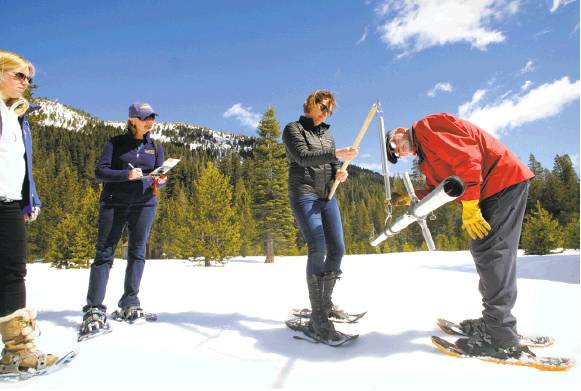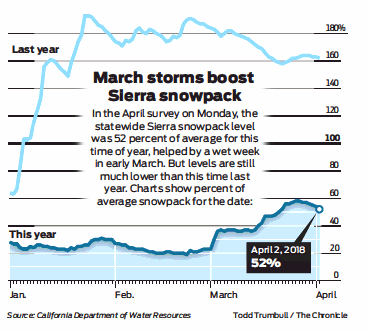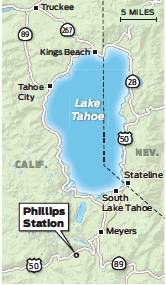Last snow survey: State to squeak by
Inbound late-season Pineapple Express will help
By Peter Fimrite
The storms of March may not have rained glory on the state, but they dropped enough snow on the Sierra to greatly improve the drought situation and, with another storm rolling in this week, water resources officials believe thirsty California will make it through the year.
The Sierra snowpack, known to water resources officials as the state’s frozen water supply, is 52 percent of average for this time of year — not great, but a lot better than it was in January and February, according to the California Department of Water Resources.
The April snow survey conducted Monday is a vital gauge of how much drinking and irrigation water is available in California because it represents the peak measurement before the snow starts melting.
The snow in the Sierra and lower Cascades provides as much as a third of the water in the state. The runoff goes into California’s sprawling network of aqueducts, which supply water districts throughout the state.
That supply will be helped out when the stormy remains of typhoon Jelawat roll in Thursday, dousing California and topping off its reservoirs, but the storm isn’t expected to change the situation much.
The state uses metal tubes to calculate the depth and water content of the Sierra snow at 250 locations, including historic Phillips Station, just north of the Sierra-at-Tahoe resort south of Lake Tahoe in El Dorado County. Surveyors there found 32.1 inches of snow Monday, with a water content — which is what drought-worried officials care about — at 12.4 inches, or 49 percent of the long-term average for that location going back to 1941.
“While we had a good March, it was not adequate to get us up to a really good outlook with respect to the water supply,” said Frank Gehrke, chief of the California Cooperative Snow Surveys Program for the Department of Water Resources. “The great advantage of this year, compared to other years with a similar snowpack, is that because we had such an abundant snow pack last year, our reservoirs are above average, so that gives us that cushion.”
Snow surveys are taken during a 10-day window around the first of every month, from January to May, and are combined with electronic measurements from more than 100 locations to gauge California’s drinking water supply for the year.
The snow level more than tripled over the course of a week in early March and kept rising. Still, it isn’t close to a year ago when the snow water content was close to double the long-term average.
The snow at Phillips, which is traditionally measured in view of the media, was 39 percent of average a month ago and 24 percent of average in January. A year ago at this time, the water content at Phillips was 46 inches, or 183 percent of the average.
Last month’s storms provided a major boost to the central part of the Sierra, including the Lake Tahoe area, where the water content is now 60 percent of average for this time of year. The storms weren’t quite as helpful in the northern part of the state, where the snow-pack stands at 43 percent of average. It is 50 percent of average in the southern Sierra.
Taken together, that’s 52 percent of average statewide.
The coming storm, which originated near the Philippine Islands, is expected to pound the Bay Area from Thursday evening through Saturday, spattering the Bay Area with unseasonably strong rain and ruining what had been a balmy spring just as Bay Area residents were pulling out their beach towels and lounge chairs.
“We’re looking at, believe it or not, another Pineapple Express taking aim at the Bay Area,” said Steve Anderson, a meteorologist with the National Weather Service. “It’s a very late-season storm. It’s a little bit unusual. Typically, we tend to be coming out of that cycle about now, but it’s lingering on one more time.”
The leading edge of the storm is currently about 1,000 miles off the coast and can be seen on satellite images stretching across the Central Pacific past Hawaii.
It is expected to drop between 3 and 6 inches of rain on the North Bay through Saturday, with Santa Rosa and Cloverdale, in Sonoma County, and Kentfield, in Marin County, getting the worst of it. Some communities along the Russian River could get as much as 7 inches.
As much as 4 inches of precipitation is expected to fall in San Rafael; 3 inches in Napa, Half Moon Bay and Santa Cruz; and 2 inches in San Francisco and Concord. The storm means at least one game of the three-game series between the Giants and Dodgers, beginning Friday in San Francisco, is likely to be rained out.
These types of sustained subtropical storms, known as atmospheric rivers, are considered rare in April.
“We’re talking 48 hours of some significant rainfall,” said Mike Pechner, of Golden West Meteorology. “That is twice the amount in some areas of the normal April rainfall.”
With snow levels around 8,000 feet, he said, the rain could mix with snowmelt and cause local flooding in the Sierra foothills. State water resources officials said they are determined to prevent the kind of flooding that happened during rain storms last month at Moccasin Dam in Tuolumne County.
In the long term, though, it is a good thing for reservoir levels in California.
“This will be a good time to collect water,” Anderson said.
There still won’t be enough water to go around once the storm passes and the snow melts, said Karla Nemeth, the director of the Department of Water Resources. The state water project is currently allocating 20 percent of the water farmers are entitled to in a good water year.
“We’ve got one word for Californians, and that’s ‘conserve,’ ” she said. “It is a new way of life.”
Peter Fimrite is a San Francisco Chronicle staff writer. Email: pfimrite@sfchronicle.com. Twitter:@pfimrite



